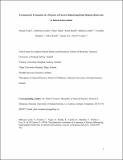Psychometric evaluation of a measure of factors influencing hand hygiene behaviour to inform intervention

View/
Date
2019-02-12Author
Lydon, Sinéad
Greally, Cathriona
Tujjar, Omar
Reddy, Kiran
Lambe, Kathryn
Madden, Caoimhe
Walsh, Chloe
Fox, Susan
O'Connor, Paul
Metadata
Show full item recordUsage
This item's downloads: 328 (view details)
Cited 5 times in Scopus (view citations)
Recommended Citation
Lydon, Sinéad, Greally, Cathriona, Tujjar, Omar, Reddy, Kiran, Lambe, Kathryn, Madden, Caoimhe, Walsh, Chloe, Fox, Susan, O'Connor, Paul. (2019). Psychometric evaluation of a measure of factors influencing hand hygiene behaviour to inform intervention. Journal of Hospital Infection, 102(4), 407-412. doi:10.1016/j.jhin.2019.02.003
Published Version
Abstract
Background
Although the hand hygiene (HH) procedure is simple, the related behaviour is complex and is not readily understood, explained or changed. There is a need for practical tools to provide data that can guide healthcare managers and practitioners not only on the ‘what’ (the standards that must be met), but also the ‘how’ (guidance on how to achieve the standards).
Aim
To develop a valid questionnaire to evaluate attitudes to the factors that influence engagement in HH behaviour that can be readily completed, administered and analysed by healthcare professionals to identify appropriate intervention strategies. Construct validity was assessed using confirmatory factor analysis, predictive validity was assessed through comparison with self-reported HH behaviour, and convergent validity was assessed through direct unit-level observation of HH behaviour.
Methods
The Capability, Opportunity, Motivation-Behaviour (COM-B) model was used to design a 25-item questionnaire that was distributed to intensive care unit (ICU) personnel in Ireland. Direct observation of HH behaviour was carried out at two ICUs.
Findings
In total, 292 responses to the survey (response rate 41.0%) were included in the analysis. Confirmatory factor analysis resulted in a 17-item questionnaire. Multiple regression revealed that a model including capability, opportunity and motivation was a significant predictor of self-reported behavioural intention [ F(3,209)=22.58, P<0.001]. However, the opportunity factor was not found to make a significant contribution to the regression model.
Conclusion
The COM-B HH questionnaire is reliable and valid, and provides data to support the development and evaluation of HH interventions that meet the needs of specific healthcare units.

